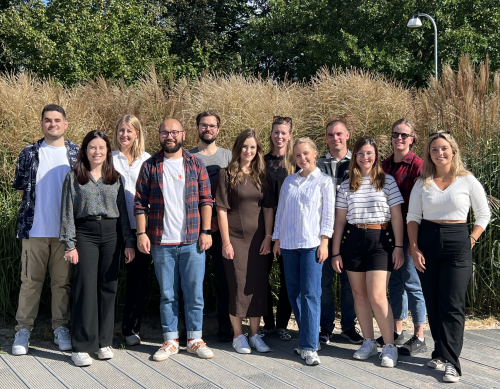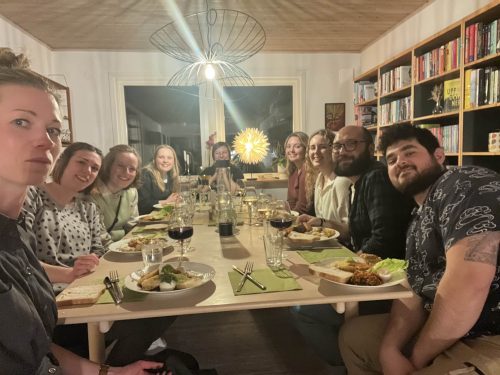Lab meeting with the Mohlin lab
Posted by the Node, on 25 March 2024
Where is the lab?
We are located in Lund, a small city in Southern Sweden. The University was founded in 1666, and consists of many old beautiful buildings. The lab is affiliated with the Division of Pediatrics, and we’re part of the Lund Stem Cell Center.
Lab website: Tissue Development and Evolution
Research summary
We are intrigued by how we can utilize the setting of normal embryonic development to understand tumor initiation. Our focus lies primarily on how cancer forms neuroblastoma and paraganglioma develop during embryogenesis. These cancers arise in the adrenal gland and along (para)sympathetic ganglia, and originate from cells of the trunk neural crest stem cell population. Neuroblastoma is the most common tumor form in infants. It is believed to arise due to developmental defects during embryogenesis, but the precise origin and cause of initiation is unknown. Paragangliomas are on the other hand adult slow growing tumors, but also these are believed to be primed during development of the neural crest. We mainly use human patient-derived cells and chick embryos to dissect the role of neural crest specific genes in cancer initiation and progression. We develop techniques where we can analyze full-scale organogenesis and tumor formation in terms of the genomic, proteomic, and morphological landscape following genetic insults in the trunk neural crest stem cell population during embryonic development.

Lab roll call
Sinan Karakaya is a postdoc, exploring the role of a dysregulated hypoxic response in both normal development and the progression of tumors, specifically focusing on paraganglioma. His research investigates the role of HIF-2α in tumor initiation, development, and aggressiveness. Sinan is originally from Turkey, and did his PhD in Germany.
Perrine Burdeyron is a postdoc working on developing a model to study neuroblastoma by using human pluripotent stem cells with chick embryo as a host. This model allows us to study different genes involved in this childhood cancer. Perrine is originally from France.
Tom Gregor is a postdoc working on the role of HIF-2α during neural crest stem cell-derived childhood cancer progression. Tom is originally from Czech Republic.
Marina Mazariegos is working as a lab engineer, and arrived to the lab six weeks ago. She is involved in several projects with different people, as well as general management and organization of the lab. Marina is originally from Spain.
Niklas Engström is a lab engineer involved in a number of projects, as well as in maintaining the structure of the lab.
Elina Fredlund is a final year PhD candidate working to understand the initiation of neuroblastoma with main focus on an early development protein that has an important role in embryogenesis and a suppressive function in neuroblastoma.
Stina Andersson is a second year PhD student, and her work focuses on how different types of neuroblastoma cells respond to various cues from the embryonic microenvironment.
Zana Stirn is a master student. She is working together with our postdoc Perrine on the project to develop a human-chick chimera model, that will be used to manipulate different genes and pathways in neuroblastoma and consequently to get a better insight into the development and origin of this cancer. Zana is originally from Slovenia.
Pleun Jornick is a master student, fulfilling the last part of her master internship here. She studies the mechanisms of a tumor-suppressor gene in neuroblastoma. Pleun is originally from The Netherlands.
Özgür Rubar Altin is a medical doctor at the beginning of his career, and he is doing an internship in the lab. He is working on investigating the role of HIF-2α in chicken embryos and different tumor cells. Özgüris originally from Turkey.
Inés Sanz is a master student, investigating the role of how embryonic microenvironmental factors affect neuroblastoma cell behavior. Inés is originally from Spain
Favourite technique, and why?
Sofie Mohlin: There are so many techniques that we can use, each with its own advantages and beauty. But I’m going to go with a ‘simple’ on: microinjections and electroporation in chick embryos. It is such a basic technique that’s been around for ages, yet it’s the basis for so many experiments and essential knowledge we have on embryogenesis today. Unfortunately, I don’t spend a lot of time on hands-on lab work anymore, but when I do it’s always by the microscope doing injections. While it in one way requires focus and concentration, I tend to go into a meditative state where I can let go of stress and just enjoy the beauty of the embryos, one after one after one…
Apart from your own research, what are you most excited about in developmental and stem cell biology?
Sofie Mohlin: I think the process of (neural crest) stem cell lineage commitment is so delicate and exciting. With the recent in-depth sequencing techniques, we’ve come a long way in understanding the genetics behind, and as a result of, lineage commitment. However, there is so much left to understand about the biology surrounding lineage commitment.
How do you approach managing your group and all the different tasks required in your job?
Sofie Mohlin: My philosophy is that people are given full independence, but it comes with responsibility. In the lab we drive the projects forward together, but each individual project is one person’s pet project (or, someone’s baby, which is my favorite way of expressing it). However, I make sure I’m always available, as often as possible physically in the lab, otherwise being quick in answering questions via email/chat functions. We also have time-fixed regular lab meetings and one-on-one meetings with PhD students. Planning and prioritization are key, but to be honest it’s not always easy. With deadlines, grant applications and academic commitments, I often feel that time for actual science is sparse. I try to be open to the group when very intense periods occur so that they know why I might be more stressed and less available for a (hopefully short) while. I’m also working on being able to say no to things. There are so many things to do, and many of these are fun tasks. But also, with a limited number of hours per day, being able to prioritize and say no is crucial. At the end of the day, the time when I’m the happiest at work is after meetings with lab members, where we have discussed cool new data, experiments, and future plans, leaving with the feeling of exhilaration. This is an activity that I would never skip!
What is the best thing about where you work?
Sofie Mohlin: My group of course! I really enjoy discussing and doing science, as well as chatting about everyday life, with everyone, be it in the corridor, in the lab, in one-on-one meetings or lab meetings. I also work close with other great PIs, providing me with a fantastic peer community and surrounding.
Sinan Karakaya: The best part of working in our research lab is the collaborative environment fostered by our diverse team. Each member brings unique perspectives and expertise, creating an atmosphere conducive to innovative thinking and problem-solving. Additionally, the supportive and encouraging nature of Sofie and colleagues nurture professional growth and fosters a sense of camaraderie, making it an enriching and fulfilling experience to be part of our research endeavors.
Perrine Burdeyron: The best thing is the positive environment in the lab.
Marina Mazariegos: Definitely the work environment created by great people working for the good of the whole lab and not for themselves. And also, the prospect of achieving goals to contribute to progress in clinical research.
Elina Fredlund: The best things are my colleagues and the abundant opportunities available. Guidance is readily accessible upon request, as people are very friendly and supportive.
Stina Andersson: I love learning new things every day, and I really appreciate the collaborative atmosphere in our research group.
Zana Stirn: The environment! I really enjoy the dynamic of the group. We have many get togethers, workshops, potlucks, fikas. All of this contributes to an amazing environment, which makes coming to work even more enjoyable.
Pleun Jornick: The ambiance in the lab is amazing. It feels you can always go to anyone with questions and that your opinion is really appreciated. This makes me really motivated to give my all.
Özgür Rubar Altin: Excellent colleagues and scientific working environment.

What’s there to do outside of the lab?
Sofie Mohlin: Lund is a very picturesque city with lots of beautiful old buildings and surroundings, so just walking around town is nice. Ten minutes on the train then takes you to Malmö, a wonderful city with lots of culture, sightseeing, parks, food, and wine bars!
Sinan Karakaya: Outside of the lab, there are plenty of opportunities to spend your time indoors or outdoors. Besides being a scenic, historical town, Lund also offers variety of indoor and outdoor activities including museums, sports halls and trails for trekking and biking.
Perrine Burdeyron: During the winter you can enjoy ice skating and snow activities and during the summer you can enjoy the long days to go for hiking and visit all the national parks in the south. If you prefer the city, we are close to Copenhagen, the Danish capital.
Marina Mazariegos: It´s a small city but you can find a lot of activities and there´re a lot of nice places to go to relax with friends.
Elina Fredlund: Crossing the bridge, Copenhagen is just a 40 min train ride away. Söderåsen is a beautiful national forest that’s worth a visit during any season.
Stina Andersson: I enjoy spending my free time in nature or at dinner with friends and family.
Zana Stirn: Lund is like a big student campus, so the student life is very much alive. You can enjoy different cafes, bars, parks and a beautiful botanical garden. On the weekend, you can make a trip to Lomma beach or one of many natural parks in the area. For some bigger city vibes, Malmö and Copenhagen are only a short train ride away.
Pleun Jornick: As an international student in Sweden there is a lot to discover, but the tradition I cherish the most here is “fika”. A coffee break with a sweet pastry a few times a week is a celebration. There are a lot of different nice cafés in Lund, so the challenge is to try them all.
Özgür Rubar Altin: Lund has incredible nature that you can explore by bike. There is a nice football stadium where you can go to watch Lunds BK.
Browse through other ‘Lab meeting’ posts featuring developmental and stem cell biology labs around the world.


 (No Ratings Yet)
(No Ratings Yet)